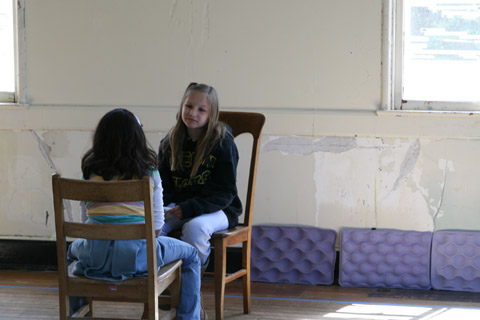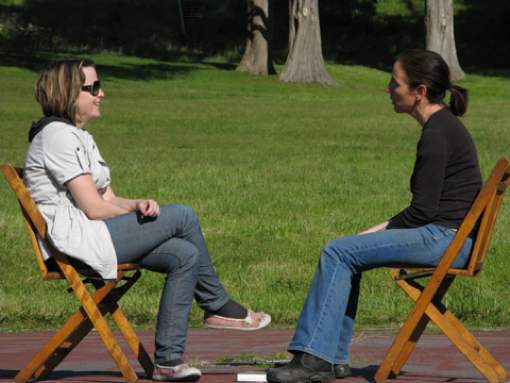In the opening scene of The Godfather, the screen is black as a voice begins to speak, and then a man’s face fills the screen as he struggles to recount the brutal assault his daughter has experienced at the hands of her boyfriend and another man. For those first few moments, we are the listener, and then, as the camera pulls back, we see we are listening over the shoulder of Don Corleone. Corleone takes in the story in weighted silence; a slight lift of his hand is enough to direct an attendant to deliver a shot of whiskey to the speaker, Amerigo Bonasera to help him collect himself.
Were it not for the fact that Bonasera proffers this story to petition Corleone to order “justice,” i.e. the murder of these two men, this exchange, in its directness, its sense of privacy, and relatively formal economy, could be taking place within Listening Booth, a public project I started in 2007 in San Francisco that investigates and enacts the power of one person listening to another.
Open-air vault, chamber without walls, Listening Booth is dedicated to sharing one of the most precious and yet infinitely renewable resources: attention. It is founded on the brightening effect of being listened to, even for a brief period of time.
Unlike Corleone’s brocade walls, the “booth” of Listening Booth is enclosed not by a structure but by regard, and the conversations transpire in public spaces.
Don Corleone tells Bonasera, “That I cannot do.” He tells him, basically, You never even came by for coffee and now you’re asking me to do this? I started this project because I, like Don Corleone, thrive on what happens when people just talk to each other, even for five minutes without checking the phone or the clock. I was becoming nostalgic for such conversations.
Sure, I talk on the phone to friends across the country, even sometimes on the relatively cozier landline that resides resolutely immobile on my desk, never dropping a call, its connection plush and supple. And yes, I am susceptible to that frisson of positive regard when a Facebook friend “Likes” my status, my link, or my, er, activity. And Gchat is so much handier for communicating with your co-worker at the next desk when she’s wearing headphones, and it was indeed efficient to send a New Year’s greeting to 800-ish friends via e-mail.
As useful as all these modes may be, however, they offer little in the way of the limbic resonance. I was curious to see what would happen if I just set up a context through which people could stop for a few minutes of face-to-face conversation with an attentive listener on the street.
A Listening Booth session in San Francisco's Dolores Park. Photo credit: Genine Lentine
The materials are simple: blue painting tape, two chairs, a small table, a small ceramic duck, and undivided attention. The chairs are set up in a public setting, and as people pass, they are welcome to talk to an attentive listener. The following options are displayed on the table and participants select how they’d like the listener to respond by placing the duck next to one of these options:
1. Silence
2. Non-lexical backchannel responses, e.g. mm hmm, nodding
3. Neutral verbal responses, e.g. I hear you, yes, I understand
4. Offering an analogous story, example, or relevant quotation
5. Advice, questions, comments
6. Freestyle
After five minutes, a timer rings, and the listener bows and says “Thank you.”
It’s a simple structure, but very rich exchanges unfold within the rectangle of blue tape on the sidewalk. Rev. Victoria Austin, a teacher at the San Francisco Zen Center, who volunteered as a listener when I first did the project for Southern Exposure’s 1st Annual Day of Public Art, observed, “People who came to the booth asked really heartfelt questions. Time stopped. And it felt private. It wasn’t as if there were curtains — you’re just right there on the sidewalk — but there was a distinct feeling of enclosure.”
On that first day, what struck me over and over was how someone’s bearing would lighten as they spoke. One person wrote in the journal, “Sometimes just knowing you are heard is enough to lighten your footsteps to a bearable level.” Another person wrote, “I set the booth to freestyle and pretty soon it was calling me on my stuff. These are beautiful days.” I was intrigued at this sense of “setting the booth.” Others talked about how they were surprised at having so much to say and that having a neutral listener had a catalytic effect.
As a poet, I always have my ear cocked and this formalizes this process, letting the listening be the actual piece itself, taking the emphasis off the product. Inevitably, comparisons to Story Corps arise. I love and admire that project and feel it arises out of a kindred appreciation of the value of direct interaction, but the primary difference of Listening Booth is that I am not documenting the participants’ actual speech, as tempting as that is, in the experience of what happens in the interaction. Taking the emphasis off “keeping” the content, I hope, allows people to feel less hindered in talking spontaneously in an unfamiliar context. Also, it is important that all exchanges are kept confidential. In writing about the project, I am careful to change or blur any identifying details.
My emphasis is on creating a context for heightened attention. Attention itself is the medium — not the peach, but the gleam on the peach. People can talk about whatever they’d like — something preoccupying them, a problem they’re trying to solve, a personal narrative, something they need to tell someone else, but can’t (yet), etc.
On a more conceptual level, listening in this way provides an opportunity for face-to-face conversation on the street when much public conversation now happens with either an absent listener — i.e. on a cell phone – or an absent speaker — i.e. with an iPod. I’m curious about how face-to-face interaction slightly shifts the general brisk-forward momentum of traffic in public spaces, allowing a small temporal dilation, a softening and widening of attention.
Listening Booth provides a form to explore two of my most abiding interests: language and interaction. And it allows me to offer something that has been of enormous benefit in my own life. I love the experience of feeling something untangle through conversation. To the extent that I can offer this to another person, it is because I have been so fortunate to have been listened to so deeply. In 2006, when I first started formulating this project, I had been working for Stanley Kunitz and had found the quality of his listening to be profoundly transformative.
A Listening Booth session in San Francisco's Dolores Park. Photo credit: Genine Lentine
Friends have often told me I am a good listener, citing what they see as a “strange confidence in the other person.” “When I talk to you, I feel as strong as I am,” one friend told me. I love the intricacy and subtlety of what happens in conversation and Listening Booth very much nourishes this enduring curiosity. This direct interaction mirrors writing poems — as when someone tells me a poem has somehow “heard [them]” and addressed something in their own lives. It’s weirdly satisfying to remove the mediation of a poem — of course I will keep writing poems, but I feel this process will inform my writing in ways I can’t know yet. I love human speech, so it’s partly just that simple: I get to listen people talking.
In thinking about this project, I imagined that people walk around brimming to talk to someone about their concerns and ideas. I imagined this, no doubt, because so often I am wishing for this. In fact, far from an enthusiastic and relieved “Yes,” when we asked people, “Would you like to talk to an attentive listener for five minutes?” what arises frequently is quite strong resistance. Responses range from “I don’t have time” or “I’m fine thanks” to a skeptical reserve about our motives. Were we selling something? Part of a religious organization? There is something inherently suspect in giving something away in a public place. The sociologist Erving Goffman talked about “free goods,” the kinds of things you can ask for in public: the time, directions, perhaps a local restaurant recommendation. To be invited to talk to a stranger about anything on your mind is, thus, a bit disorienting. But more often when people saw an exchange in process, they became curious and stood in line.
After the session, people are invited to write in a journal. Here are some examples of those entries:
- Who knew I had so much to say? Thanks for letting me talk.
- This is an inspired idea. You are like a catalyst, letting all these things people are thinking get out and moving. Thank you for helping.
- Thanks very much! I am amazed at how much I learned and understand about me in five minutes of your listening to me and giving me some feedback. Thanks again!
- Five minutes? Through a little everyday doorway, I found strong feelings and tears came — just beneath the surface — a kind heart, caring eyes brings it all forth. Thank you. Amazing.
- How often do we get listened to fully? If everybody got this several times a week/as needed, how would the world be different?
- The vulnerability of exposure flowers with the receptivity of the listener. I was listened to, and I am feeling pretty naked right now.
- This is the place. A basic gesture of two bodies speaking and listening with deep generosity.
- Thank you for being here and making my day. Listening is such an ignored aspect of life. Thank you for reminding me to listen more to others and to myself.
The primary discovery that came with the first day of doing this project was that I did not need to be the listener. I had originally conceived of the project that way, that I would be the main listener, and there would be “guest” listeners. But on that first day, I saw how people not only wished to be listened to, they wished to be in the role of listener. I was surprised at this at first, thinking people always have that available to them, but there is something about the ecology of the exchanges that allows them to listen in a focused way that makes it very inviting. What many of them said was that the opportunity to listen to “strangers” was part of the appeal, to just drop into a rich exchange with someone they’d otherwise pass on the street.
Many speakers are unaccustomed to having the “floor,” uncontested, and associate this permission with performance. On the first day, one person sat down and recited a poem to me, one that had the feel of something stored in memory since high school and trotted out for occasions just as he seemed to have imagined this one to be — one in which he had to earn my interest. And this is one of the primary questions I’m exploring in this project. Who are we when we don’t need to jockey for the floor and how do we do this subtly all the time? I wonder what happens physiologically when someone has the feeling of being fully listened to. Is there a physiological counterpart to that sense of the “monitor” dropping in the face of an attentive listener? Does that rich, positive regard show up in the pulse? In respiration? In the endocrine system? It would be interesting to compare face-to-face conversations, texts, and e-mails to see what is happening in the body with these kinds of exchanges.
Each session ends after five minutes, though participants may return to the line for another session if they wish. This stands in contrast to ending a regular conversation, which can be a highly delicate affair in which one speaker must communicate to the other person that her regard for that person is still intact despite the rupture that’s about to happen so she can go to the gym. We have many discourse markers indicating a turn toward summation. For example, when your friend says, “So anyway,” you can feel the end of that conversation beginning.
A Listening Booth session on the basketball court at Headlands Center for the Arts. Photo credit: Vajra Spook
In linguistics, these are called pre-closing strategies. Often, even though the speaker is looking out for his/her own interests, he/she will often invoke the projected needs of the other person, as in, “Well, I know you must need to get back to work.” Or the speaker will appeal to lack of choice in the matter, “Well, gotta grade these papers.” In Listening Booth, these negotiations are minimized. It’s simply that the timer rings and there’s someone waiting in line. There’s no perceived judgment that maybe it’s ending because the speaker is boring or burdensome. Most exchanges end on a somewhat cheery, light note, even if the subject matter has been sensitive.
I’d wondered if a full day of listening to people might leave me feeling fried. Instead, I felt buoyant and I think that was in part because so much of this transitional “facework” (Erving Goffman’s term for the ways we communicate our regard for each other), coming in and out of each exchange, was performed implicitly in the form itself.
Many friends have joined me in offering the project around San Francisco, mostly in Dolores Park, so far. I offered the project as part of a two-week residency at the Headlands Project Space in April or 2009. In another variation, Brian Fisher, one of the world’s authorities on ants, and I collaborated on a project called “Advice from Underground” for one of the California Academy of Sciences Nightlife programs. We gathered some of his colleagues in myrmecology to sit in the African hall in front of the dioramas and people could sit and talk with them, but with the twist that they could seek advice on matters of their own life from the perspective of these ant experts. When the Levi’s Workshop was on Valencia, Adam Katz and Dan Connortown allowed me to set up in front of the space on a Saturday and that yielded some wonderful exchanges. Most memorably, a woman sat down and selected “Advice” and announced that she was on the first few minutes of a blind date and was trying to figure out how to gracefully end it.
One afternoon when we were at Dolores Park, I was handing out fliers on the hill and handed one to a guy on his cell phone. He interrupted his call to ask me about what we were doing and then got back on with his friend, “This is the coolest thing. This chick just came up and said she’d listen to me.” He got off the phone and kept asking me, “Will you really just listen to what I have to say?”

A Listening Booth session at the Headlands Project Space. Photo credit: Marian Heinkel
A couple of hours later, he showed up. As he spoke, I was struck by the way his whole frame of reference for someone listening to him was scatological, as if anything he’d ever shared with anyone had been received as such. “Thanx 4 letting me dump on U,” he wrote in the journal. I felt glad to be able to offer him an experience of being listened to that was perhaps more receptive than what he was used to. I mostly just nodded as he unspun words for what almost seemed to be his first sensations of unanesthetized pain, as he had recently become sober. Though I had said almost nothing, he said, “You’re pretty smart, for a chick.” Then he left and came back at the end of the day for another session.
Listening Booth is very portable, and I’m looking forward to continuing to explore it in different contexts. Some friends who have participated in the project have started offering it themselves, and I enjoy the thought of people offering these sessions in different cities — a seamless social resource not dependent on real estate, but depending only on one person paying attention to another person.
For more information, visit www.listeningbooth.org. I welcome anyone interested in being a listener to get in touch here.









